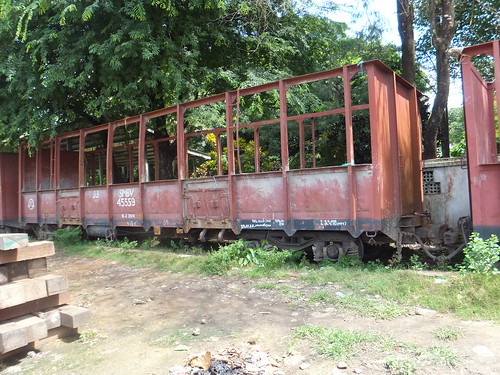This is a rather informal listing of types of vehicles I've come across. Originally, 'Chopper' couplers were used throughout Burma and, where required, vacuum brakes. On more recent equipment, 'Automatic' couplers (similar to the British 'Buckeye') are fitted with single-pipe air brakes.
Tank, Bogie, Oil code TBOHV

Original size.
The standard tank wagon for oil is seen with 'Chopper' couplings. Vacuum Brakes are fitted.
Tank, Bogie, Petrol code TBPHV

Original size.
Three Tank wagons for petrol can be seen in the background of this picture.
Mineral, Bogie code MBHAH

Original size.
Bogie Mineral Wagon, 30 ton capacity fitted with automatic couplers and air brakes.
There's also a 4-wheel long-wheelbase version coded 'MHV' with 18-ton capacity (not illustrated).
Bogie Goods Van code GBHV
 Original size.
Original size.
Bogie Goods Vehicle. The examples shown are marked with capacities of 33 tons and 32 tons. Other examples, of a slightly different construction, are marked 36 ton capacity. They are fitted with two doors on each side. Each door is either sliding or, in some cases, made with two vertically hinged leaves with a third horizontally hinged section at the bottom. A similar-looking vehicle is coded 'PBHV'.
Bogie Goods Van code GBQV
 Original size.
Original size.
Early boxvan retained for storage.
Livestock Wagon code SMBV

Original size.
Open wagon with framework allowing load to be sheeted, where required. The wagon shown has automatic couplers and air brakes.
Bogie Flat Wagon code WBY

Original size.
Two examples of this type, with the loads sheeted over, can be seen in this picture. They are marked as 30 ton capacity and fitted with chopper couplings.
Brake Van code VBH
>

Original size.
Bogie long-wheelbase Freight Brake Van.
Wednesday, 3 April 2013
Freight Rolling Stock in Burma
Passenger Rolling Stock in Burma
This is a rather informal listing of types of passenger vehicle I've come across. Originally, 'Chopper' couplers and vacuum brakes were used throughout Burma. On more recent equipment, 'Automatic' couplers (similar to the British 'Buckeye') are fitted with single-pipe air brakes.
Ordinary Class Bogie Daycoach code BDT)
Original size.
Ordinary Class Bogie Daycoach, cream and brown with a blue waistline. A modified version has been seen in blue and white with a red waistline.
Upper Class Bogie Daycoach code BDUEZ
Original size.
Upper Class Bogie Daycoach, cream and brown with a blue waistline.
Ordinary Class Bogie Daycoach code BDTE(subscript LED)Z
Original size
Ordinary Class Bogie Daycoach fitted with chopper couplings. No brakes on this example. The 'LED' presumably indicates that the original roof lighting fittings have been replaced by panels of white light emitting diodes.
Restaurant Car code BREZ
Original size.
The coach on the left is a Restaurant Car, painted blue and white with a red waistline.
Upper Class Bogie Sleeper code BNUE(subscript LED)Z
Original size
Upper Class Bogie Sleeper fitted with automatic couplings and improved corridor connections.
Ordinary Class Bogie Coach code SMBDT
Original size
Ordinary Class Bogie Coach fitted with chopper couplings and vacuum brakes. Grey and dark blue with a white waistline.
Ordinary Class Bogie Coach code LBTX(RC)(J)
Original size.
Ordinary Class Bogie Coach painted blue and green.
Four-wheel Passenger Coach code LZBT
Original size.
Four-wheel passenger coaches with chopper couplings and no continuous brake pictured at Bago. Livery: white and brown with a blue waistline.
Bogie Guard's/Luggage Van
Original size.
Bogie Guard's/Luggage van. Chopper coupling, originally vacuum braked. Livery: cream and red.
Bogie Guard's/Luggage Van/Ordinary composite code BBDTE(subscript LED)Z
Original size.
Bogie Guard's/Luggage/Ordinary composite. Chopper coupling, vacuum braked, improved corridor connections. Livery: cream and brown with a blue waistline.
Bogie Guard's/Goods Van code VBHV
Original size.
Bogie Guard's/Goods van with two sliding freight doors, Guard's door and ducket on each side. Shunter's step on end. Chopper coupling, originally vacuum braked. Capacity marked as 31 tons. Versions exist with 3-leaf hinged freight doors. Included with passenger vehicles as often seen on passenger trains.
Bogie Coach code BISE
Original size.
Appears to be a passenger design. Note end incorporates a tail lamp. Fitted with chopper couplings. Originally fitted with vacuum brakes, now removed. Livery: blue and brown with cream waistline.
[BBDTE(LED)Z added and minor changes 4-Apr-2013]
Diesel Railcars in Burma
This is a rather informal listing of types of railcar vehicles I've come across.
Lightweight Diesel Railcar (RBE)
Original size.
Railcar RBE.2546 arriving at Puzundaung Station, en route for Yangon. The railcar is provided with 'Automatic' couplers, presumably for attaching a trailer car.
Diesel Railcar, 5000-series (RBE)
Original size.
Puzundaung Station: On the right diesel railcar RBE 5011, believed to be of Japanese manufacture, arriving from Yangon. Elsewhere, a defunct unit similar to RBE2011 was seen, locomotive hauled, in use as a coach. A second unit, RBE 2522 (similar to RBE 2508 illustrated below) can be seen on the rear of RBE 5011.
Diesel Railcar, 2500-series (RBE)
Original size.
Diesel railcar RBE 2508 under repair at Katha.
Railcar Trailer Car (RBT)
Original size.
Diesel railcar trailer car 827, paired with the repaired RBE 2508.
Railcar Trailer Car (RBT)
Original size.
Diesel railcar trailer car 802, forming part of a locomotive-hauled train.
Very-Lightweight Diesel Railcar
Original size.
Very-lightweight diesel railcar (chopper couplings, livery white with yellow roof and red line) leaving Myo Haung with three 4-wheel coaches LZBT.
Recent Developments
These DMU spotted adjacent to Yangon Central station in February 2013 may be part of the Japan International Co-operation Agency (JICA) project in Myanmar. The JICA website referring to work in Myanmar says "a proposed multi-million dollar project will upgrade the maintenance and safety of railroad infrastructure, most of it dating from the pre-World War 11 British colonial era". The above picture shows what may be new or rebuilt Japanese units. The unit on the left carries a Myanmar Railways style running number 'RBE 2586' whilst the unit of a different on the right carries the number '301'.
